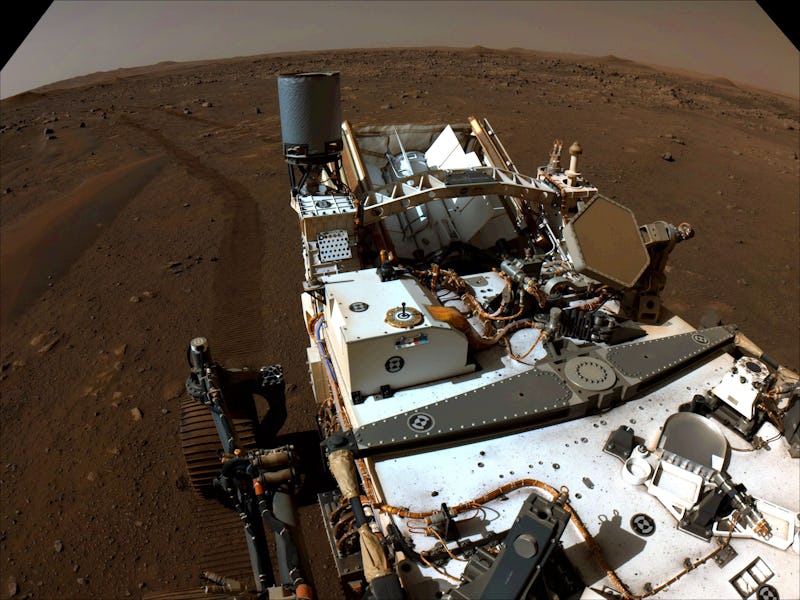What organic molecules found on Mars mean for the existence of life
The rover's predecessor discovered a new set of organic molecules, and Perseverance will help paint the full picture.

For nine years, NASA’s Curiosity rover has been roaming a giant impact basin on Mars, searching for biosignatures. About 2,300 miles away, its successor Perseverance is collecting samples from Mars’ Jezero Crater and stowing them for a future return mission to Earth.
The same mission unites the two robots: discover signs of ancient life on Mars. But they are equipped with different parts that put together pieces of the puzzle of the history of the Red Planet.
The Curiosity rover recently discovered a new set of organic molecules on Mars, according to a new study published Monday in the journal Nature Astronomy.
The two most significant molecules were benzoic acid and ammonia. Although these molecules are not biosignatures, they are a promising first step in identifying potential signatures of past life on Mars.
The Curiosity rover has used the drill on its robotic arm to take 32 rock samples to date.
“I think that came as a surprise, that curiosity discovery,” Sanjeev Gupta, a member of the Perseverance science team, tells Inverse. “We wouldn’t have thought that you’d find organics within the sand dune deposits.”
Scientists did not expect the sample to be rich in well-preserved organic molecules since ionizing radiation had long battered the ancient soil. Organic molecules are considered the building blocks of life on Earth — which could carry over to elsewhere in the universe.
Maëva Millan, a postdoctoral fellow at NASA’s Goddard Spaceflight Center and lead author of the new study, explains that they are still looking over all the data collected by Curiosity.
“I’m still trying to, of course, find those biosignatures,” Millan tells Inverse. “But all the organic molecules could tell us more about the Martian history and past habitability.”
This isn’t the first time Curiosity has found organic molecules. In 2018, Curiosity found organic molecules in three-billion-year-old sedimentary rocks near the surface of Mars.
NASA designed the Curiosity rover to sniff out organic molecules. The team behind the latest discovery made it through a complex chemistry experiment within the rover’s belly.
The rover has a built-in Sample Analysis at Mars (SAM) instrument that measures organic chemicals in samples collected by Curiosity on Mars. Meanwhile, Perseverance’s design gives priority to the sample return aspect of the mission.
“SAM obviously occupies a lot of space on the rover, and it’s very, very power-hungry,” Gupta says. “There was no point — why would we do that on Mars if we’re bringing the samples home?”
Perseverance is supposed to collect at least 20 samples from Mars using a drill attached to the robot’s arm.
The samples move through the robot’s belly and into the Adaptive Caching Assembly System, where they are assessed and processed. The assembly system contains seven motors and more than 3,000 parts, including the Sample Handling Arm used by the rover to hold sample tubes.
“So obviously, the space on Perseverance is taken up with sample handling,” Gupta says. “They weren’t going to have very detailed analytical instruments on [Perseverance] Because we’ll do that on Earth with the sample return.”
Once it has collected its samples, Perseverance will leave them behind on Mars for a pickup mission planned within the next 10 years or so.
Perseverance captured this image during its first drive on Mars on March 4, 2021.
NASA will send a Sample Retrieval Lander mission to land on a platform near the site where Perseverance stowed the sample tubes. Once the platform touches down on Mars, a small rover designed by the European Space Agency (ESA) will roll out and grab the samples.
The rover will place the samples into a single large canister, which it will load onto the Mars Ascent Vehicle. This vehicle will then liftoff from Mars, carrying the canister into Mars’ orbit, where another spacecraft will be waiting to catch the canister.
The orbiter will drop off the samples on Earth, where scientists can analyze them in a lab.
“On Curiosity, we have other kinds of instruments to do some analysis, and it’s going to help us determine the best samples we want to bring back to Earth,” Millan says.
This is the first time scientists have gotten their hands on samples from Mars, so the samples have the potential to unlock Mars’ past habitability and whether the planet ever hosted some form of life.
“Bringing the samples back to Earth would allow us to use the best techniques we have so far,” Millan adds. “When we send an instrument to space, we are limited with energy and space.”
Curiosity may have discovered organic molecules on Mars, but its successor Perseverance can help identify where they originated from and how they fit into the bigger context of Mars’ history.
“I think what we’re discovering is that Mars is complex,” Gupta says. “And so we’re teasing out all these little details.”
“There are lots of small-scale discoveries, and they’ll come together to a broader framework for Mars, but we’re not in that broader framework at the moment.”
This article was originally published on